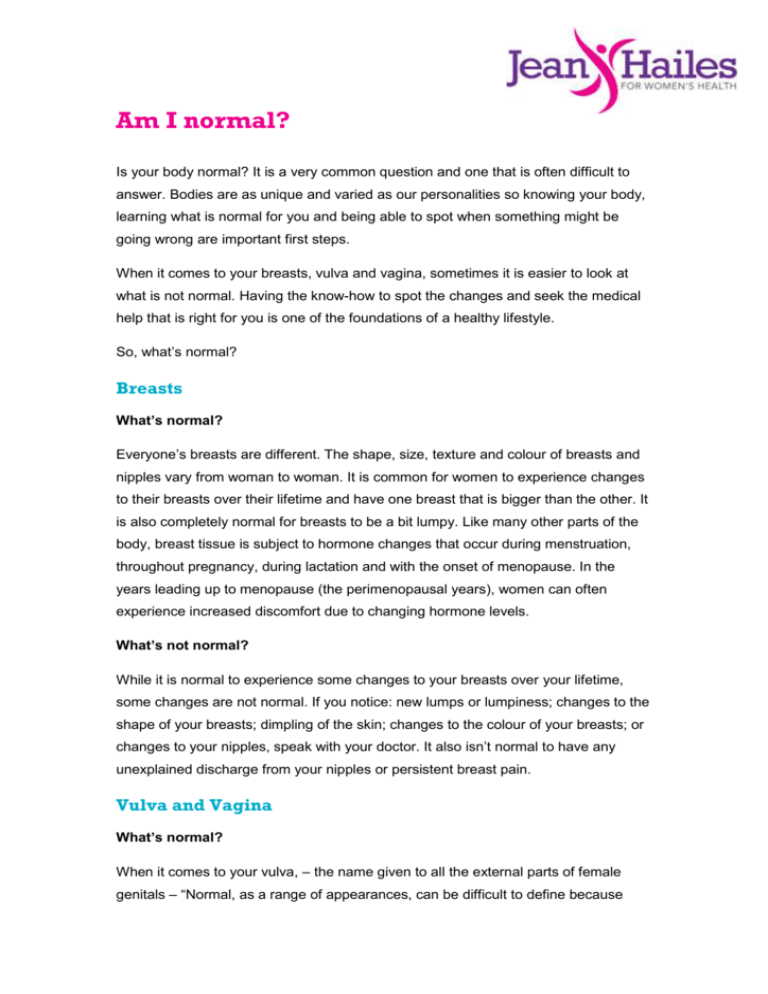Am I normal? - Jean Hailes
advertisement

Am I normal? Is your body normal? It is a very common question and one that is often difficult to answer. Bodies are as unique and varied as our personalities so knowing your body, learning what is normal for you and being able to spot when something might be going wrong are important first steps. When it comes to your breasts, vulva and vagina, sometimes it is easier to look at what is not normal. Having the know-how to spot the changes and seek the medical help that is right for you is one of the foundations of a healthy lifestyle. So, what’s normal? Breasts What’s normal? Everyone’s breasts are different. The shape, size, texture and colour of breasts and nipples vary from woman to woman. It is common for women to experience changes to their breasts over their lifetime and have one breast that is bigger than the other. It is also completely normal for breasts to be a bit lumpy. Like many other parts of the body, breast tissue is subject to hormone changes that occur during menstruation, throughout pregnancy, during lactation and with the onset of menopause. In the years leading up to menopause (the perimenopausal years), women can often experience increased discomfort due to changing hormone levels. What’s not normal? While it is normal to experience some changes to your breasts over your lifetime, some changes are not normal. If you notice: new lumps or lumpiness; changes to the shape of your breasts; dimpling of the skin; changes to the colour of your breasts; or changes to your nipples, speak with your doctor. It also isn’t normal to have any unexplained discharge from your nipples or persistent breast pain. Vulva and Vagina What’s normal? When it comes to your vulva, – the name given to all the external parts of female genitals – “Normal, as a range of appearances, can be difficult to define because everyone is different,” says Gynaecologist Dr Elizabeth Farrell. “Every vulva is unique in its shape and size.” Evidence suggests that many women don’t know what a “normal” vulva looks like; their understanding of the “ideal vulva” can come from images presented to them in the media. The truth is, genital appearance is as varied as facial appearance. What about the vagina? All females experience vaginal discharge or secretions. This discharge is designed to keep the vagina moist, remove bacteria and dead cells and can vary in consistency across the menstrual cycle. It is also normal for your vagina to have an odour that can change at different times of your cycle and after menopause. What’s not normal? An itchy, red, burning or swollen vulva is not normal and you should speak to your doctor if you are experiencing any of these symptoms as they could indicate a skin condition, an allergic reaction or bacterial infection. While vaginal discharge is normal, a significant change in the colour and consistency of your discharge could be consistent with an infection. Similarly, if your vaginal smell has changed to an unpleasant odour, this could be symptomatic of an infection and it is a good idea to speak with your doctor. Get to know your body Being familiar with your body and how you think can help you to recognise when things might not be normal. Conduct regular breast checks so that you know how your breasts look and feel. This will help you to spot any changes, should they occur. Look at your vulva and vagina with a hand mirror so that you get to know what is normal for you. Just like your breasts, this will make it easier to identify any changes you may experience. It is also a good idea to become familiar with your vaginal discharge and how it changes over the course of your menstrual cycle. This way, if there is anything out of the ordinary, you will know. Published with the permission of Jean Hailes for Women's Health jeanhailes.org.au 1800 JEAN HAILES (532 642)











